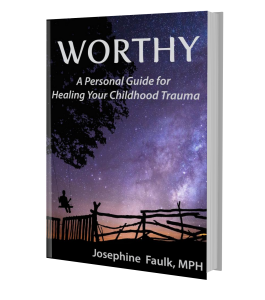EMDR Heals Childhood Trauma for Millions
by Josephine Faulk, MPH · Published · Updated
EMDR – Eye Movement Desensitization and Reprocessing
This is the third post in the series Dismantling The Trauma That Haunts You.
If you intend to embark on recovering from the effects of your childhood trauma EMDR must be an integral part of your strategy. Why? Put simply, because many of us with post childhood trauma symptoms have seen multiple therapists, attempted suicide one or more times, self-medicated with our compulsions of choice and read self-help books till our eyes bled, with little to no relief. After years of this we are sick of repeating our stories and we just want to put it all in lock-down. As we now know,
“Buried feelings never die.”
Some of us could benefit from having this tattooed on our body in a prominent location.
EMDR has been used worldwide to successfully heal millions of people. Its success rate is 84-90%. It is recognized and approved by the American Psychological Association, the American Psychiatric Association, the Department of Defense, US Department of Veteran Affairs, the Israeli National Council for Mental Health, the United Kingdom Department of Health and many other organizations internationally.
I want to walk you through one EMDR session so you can get a good feel for what to expect. The best thing, as far as I’m concerned, is that we do not have to revisit any of our traumas in detail. Before my therapist and I began EMDR we spent a few sessions building up my internal support system. I was asked to visualize (guided imagery) a room, a conference room, and he began to describe it, I told him I could do that. I turned it into a huge, beautiful stable. I could see horses from my (visualized) room where I sat on a large, comfy sectional sofa.
He instructed me to invite whomever I wanted into this room to provide me with love and support while we explored what my mind (meaning my wounded inner children) wanted to start with. My grandmother came, my brother who drowned at three and my Norwegian Elkhound, Kilo (what can I say, it was the 70’s) I’d had as a teenager, came to support me. As I saw myself with them and felt their love for me, my therapist handed me two small paddles, each about the size of a half dollar, with a slender cord attached to each. I placed one under each thigh. He turned them on to begin the bilateral stimulation which would help promote the good feelings I was having and help me relax. My therapist had me choose one emotion-evoking image to represent one trauma. It was my little brother face-down in the bottom of the pool. I was to be my child self, so I crawled into my (visualized) Nana’s lap- I was five. He said, “There is a large television screen in the room. Look at it with the image you’ve selected, only in black and white, as that helps lessen the impact.” We began to peel back one thin layer of this trauma that day.
During the EMDR I would feel relatively the same emotions I did originally. My therapist was there to monitor how much I was capable of processing and to ensure I was not re-traumatized. The physical and emotional aspects of the trauma-charge manifested in my adult body as tension in my chest, head and across my upper back, a place I’ve unknowingly held tension my whole life. I wept as layers of emotionally charged memories processed. My therapist would help me control the intensity by bringing me back to the present repeatedly with comments, encouragement and short questions. All the while the paddles were softly vibrating, first the left, then the right, over and over, affecting the left and right sides of my brain. We would spend many sessions working on this one incident alone. It took a few months. Each trauma takes as long as it takes. You cannot predict how long it will take you to work through it. The more you do EMDR the better you get at keeping yourself present and processing longer and deeper. Your therapist learns to read you intimately, which is why trust in their ability is of utmost importance.
The results of EMDR are that the emotional charge of your unresolved, original trauma, which has resided throughout your body and remained stored in your limbic brain since it occurred (decades ago for some of us) discharges its negative, draining energy. This happens layer by layer, session by session. Each week, following an EMDR session, you can expect flashes of clarity. Suddenly you will “get” something that has evaded you your whole life. Triggers start to dissipate, some disappear completely. Your self-critic gets smaller, less intrusive, quieter, more controllable. You quit being so damn mean to yourself.
You may be thinking this all sounds like too much of a risk. It wasn’t at all what I had in mind when I first called my therapist. I told him quite firmly, “I’ve already dealt with my past and I don’t even want to talk about that anymore. I just want to start where I am now and work on my current behavior.” He replied he would at least have to take a brief family history. I grudgingly agreed. I arrived and greeted him confidently. I sat lightly on the edge of the couch ready to get on with it. He took out a pad of paper and asked me a few simple questions about myself. Then he said he just needed to ask me a few questions about my childhood. What happened next came out of nowhere. I never saw it coming. Suddenly my entire body stiffened like a board, my eyes flew wide-open in abject terror and I could not breathe nor move my eyes. He spent the rest of the session peeling me off the ceiling. “Okay, so maybe I have a couple of things we should address,” I said quietly.
You are not going to have everything come crashing into your conscious at once. Your brain knows better than to do that to you and so will your therapist. I have left a session weak as a kitten, make-up all cried off but with this curious sense of having freed a part of my True Self. Life incrementally becomes richer, you become happy for no reason, you are gentler with yourself and your emotional reactions become less intense. EMDR can do for you in two to three years what would take seven years, or more, of just talk therapy. It works for nearly everyone who tries it and the trauma that is discharged, stays gone. Eventually, your personal narrative becomes a story you can share that no longer shreds you in the telling.
Make sure at the end of each session your therapist walks you through a visualization of taking everything you worked on that day and placing it in a container and sealing it up till the next session. I was so afraid of that first trauma popping up in my life between sessions I put it in a metal dumpster, welded it shut and then put big chains around it with huge locks. That sucker wasn’t going anywhere! I know it sounds a little silly, but it WORKS! Trust me, you want to do this. I purposely did not visit anything from our sessions between sessions, although I did journal after every one and recorded any subsequent effects, realizations and bodily sensations. I can’t stress enough how valuable journaling this whole process will be for you.
My next post will cover the Emotional Freedom Technique (EFT). Our entire body functions via electrical signals that enable and control our every move, even our thoughts and emotions, including those unwelcome erratic, emotional triggers. Come learn how and why EFT works and how you can use it to gain control of your triggers.
Available at Amazon > Worthy: A Personal Guide for Healing Your Childhood Trauma
We’d love to have you join our Worthy As We Are Community. Sign up is in the sidebar. You will receive:
Lesson One and Exercise One of The Body As A Sacred Space immediately.
Copyright ©2018 Josephine Faulk, MPH. Excerpt from WORTHY A Personal Guide For Healing Your Childhood Trauma by Josephine Faulk,MPH. Available, along with accompanying Workbook, on Amazon.






Is there a practitioner in winnipeg manitoba
Claudia here is a site with a list of counselors who do EMDR in Winnipeg https://therapists.psychologytoday.com/rms/prof_results.php?city=Winnipeg&state=MB&spec=301
Also you may want to read this previous post for further guidance on your initial steps toward recovery. Love and light to you.
Josephine